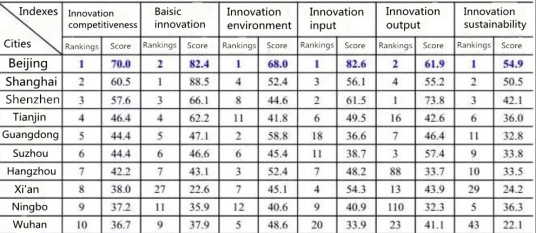Beijing ranks first in China’s urban innovation competitiveness
China's first Urban Innovation Competitiveness Report in 2018 (the "Urban Innovation Blue Paper") was officially published and released at a launch event held by the Chinese Academy of Social Sciences this Wednesday.
 |
|
Beijing tops the rankings in China’s first Urban Innovation Competitiveness Report in 2018 [Photo provided to chinadaily.com.cn] |
According to the blue paper, Beijing, Shanghai and Shenzhen are ranked the top three among Chinese cities for urban innovation competitiveness. Among the five first-class indexes, Beijing's innovation environment, innovation input and innovation sustainable development are best throughout the nation and a source of the city’s high competitive level.
The blue paper builds an indexed evaluation system of China's urban innovation competitiveness from five aspects, namely basic innovation, innovation environment, innovation input, innovation output and innovation sustainability.
Composed of one first-class index, five second-class indexes and thirty-one third-class indexes, the Academy’s system and its mathematical model provides a comprehensive evaluation and analysis of innovation competitiveness in 274 Chinese cities.
It also provides research into specific municipalities, sub-provincial cities and regions, which reveals the characteristics and relative differences of urban innovation competitiveness among cities of different types and development levels, clarifying their advantages and weak points.
 |
|
Rankings and scores of the top ten cities in the innovation competitiveness report [Photo provided to chinadaily.com.cn] |
The blue paper was completed by researchers in the "Research Group of Urban Innovation Competitiveness", a joint participation by Fujian Normal University and other institutions. The paper ranks Beijing, Shanghai, Shenzhen, Tianjin, Guangzhou, Suzhou, Hangzhou, Xi'an, Ningbo and Wuhan from first to tenth.
Among the five second-class indexes, innovation output contributes the most to urban innovation competitiveness, with an average contribution rate of 33.8%.
The contribution rate of innovation environments comes in second, reaching 21.3%; innovation sustainability and input contribute 18.0% and 14.6% respectively; basic innovation contributes the least at 12.3%.
Accordingly, Chinese cities need to pay special attention to innovation output, innovation environments and innovation input to reach and maintain high competitiveness. Also, innovation sustainability and basic innovation should not be neglected.
To be specific, basic innovation is shown mainly by six indicators: GDP, per capita GDP, fiscal revenue, per capita fiscal revenue, foreign direct investment and financial deposit balances.
Innovation environment has six measures: the number of Internet users per thousand people, the number of mobile phone users per thousand people, the number of national high-tech parks, the number of national high-tech enterprises, the number of colleges and universities and the e-government development index. Beijing is ranked first on this index.
 |
|
Zhongguancun can be regarded as a representative of Beijing’s innovation competitiveness. [Photo provided to chinadaily.com.cn] |
Innovation input consists of R&D expenditure (referring to the total social research and experimental development expenditure), the proportion of R&D expenditure in GDP, per capita R&D expenditure, R&D personnel numbers, the proportion of R&D personnel of all staff members and the proportion of financial and scientific expenditures of general budget expenditures. Beijing is also ranked first in this field.
Innovation output is determined by the seven indicators of the number of granted patents, the output value of high-tech industries, the total export volume of high-tech products, the proportion of the export volume of high-tech products, the labor productivity of the whole society, the number of registered trademarks, and the pollution discharge per unit of industrial output. On this index Beijing ranks second only to Shenzhen.
Innovation sustainability has six indicators: total public education expenditure, the proportion of public education expenditures of GDP, per capita public education expenditures, the growth rate of scientific and technological personnel, the growth rate of science and technology funds and per capita disposable income of urban residents. Beijing is ranked first on this aspect.
Chinese cities may well use this report to emphasize the kinds of innovation, such as innovation output, innovation environment and innovation input, as measured by the indexes, to develop a high level of competitiveness both domestically and internationally.
